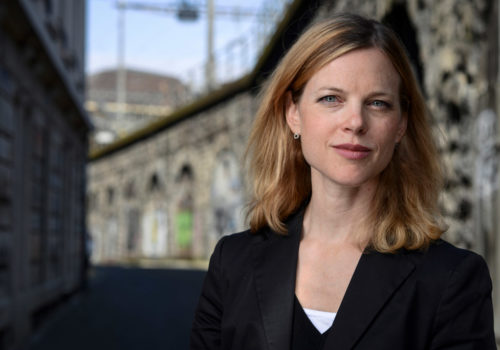Nathalie Herschdorfer is the “godmother” of this year’s edition of the Festival Circulation(s), succeeding Xavier Canonne, François Cheval, Christine Ollier and Laura Sérani in years previous . Herschdorfer is currently the director of the Musée des Beaux-Arts in Locle, Switzerland. As curator of Circulation(s), she gave carte blanche to four young photographers from Spain, the Ukraine, Switzerland and the Netherlands. What she presents to us is an evolving Europe, and different visions of today’s youth: from Ukrainian photographer Ola Lanko’s snapshot portraits to Spaniard Danès Savi’s work on the emptiness of relationships in a frozen town, from the colorful folk gatherings shot by Swiss photographer Cyril Porchet to the diptychs from the series Tokyo Tokyo by the Dutch artist duo Wassinklundgren.
Three questions for Nathalie Herschdorfer:
L’Oeil de la Photographie: You are the “godmother” of this year’s festival, its fifth. What does your role entail?
Nathalie Herschdorfer: I participated in the selection of the works on display with members of the association Fetart. We looked at hundreds of portfolios from across Europe. It’s fascinating to be carried away by the work without knowing which ones are going to be the discoveries of the year. After the jury settled on a selection of 21 photographers, I put together my own “carte blanche” with the work of four photographers.
LODLP : How did you make your own selection?
NH : It’s a privilege to be given a “carte blanche.” I waited for the jury’s selection before bringing together my own four artists. For the past few years, I’ve witnessed the disappearance of photographic genres that were essential to previous generations. One of them is street photography. The photography of the 20th century brought this genre to its peak, and there are still some photographers who fight under its banner. There are even groups that meet on the internet.
But young photographers, and especially those I found in art schools, don’t seem very interested in street photography. So I wanted to find out what a street photographer could be like today, in this generation. There are those who question the genre, like Wassinklundgren, asking whether or not the decisive moment really exists; those who turn it into an abstraction, like Cyril Porchet, whose work resembles a Jackson Pollock drip painting; those who photograph people without their knowledge, like Ola Lanko; and, finally, those who engage with passers-by for a split second, like Salvi Danes.
Working in a public space and observing people remains a possible avenue for young photographers, but how they see differs greatly from their predecessors.
LODLP : What are some of your favorite discoveries from this year?
NH : The images of Anni Hanen made with her son, and Laurence Rasti’s report on homosexuals in Iran, touched me deeply.
And I love the work of Epectase, Lonneke Van der Palen and Romain Mader, who bring a much needed dose of humor to our lives. The same is true of Guillaume Martial’s series Le Modulor, it’s absurd and burlesque!
Audrey Laurens’s work is particularly fascinating in an era where people spend so much time in front of their screens. Her distributor of small photographic portraits attests to our attachment to photography as a physical object. Who doesn’t want to buy a little card and treasure it like a relic?
FESTIVAL
Circulation(s) #5
From January 24th to March 8th, 2015
CentQuatre
5 rue Curial
75019 Paris
France
Free Entrance
M° : Riquet or Stalingrad
Tuesday – Friday 1pm – 7pm and Week-end 12pm – 7pm
http://www.festival-circulations.com
http://www.fetart.org
http://www.mbal.ch
















